There hasn’t been a major overhaul of the tax code in three decades. More notably, Reagan’s signature achievement required four years of deal making between the executive and legislative branches of government. Tax-code reformation did not transpire overnight.
Yet many investors seem to think consequential tax reduction for corporations as well as tax cuts for the middle class is a cinch. It won’t be. There are debt-weary Republicans who are not likely to rubber stamp a package if it appears to favor the uber-wealthy alone; others may balk if changes contribute to out-of-control deficits.
Do I think that the Trump team and Congress will stumble as badly as they did on the health-care bill? No, I do not. They’ve probably learned a thing or three. In fact, they’ve probably discovered the importance of the perception of victory.
Rather than a corporate profit bonanza due to tax breaks, then, tax relief is likely to be modest at best. Investors should be prepared for a whole lot of hype. (This one has “buy the rumor, sell the news” written all over it.) What’s more, Congress still needs to approve a budget – a budget that also requires a debt ceiling compromise. We are looking at mid-July before leaders can even take up the tax issue in earnest.
Strikingly, many in the investing public discount the limitations of fiscal stimulus. They also disregard the headwinds of a Fed tightening cycle, unsustainable debt levels, unfavorable trends in credit as well as stock valuation extremes.
Federal debt, for example, has been growing at 4x the rate of the economy since the beginning of the 21st century. It has been expanding at 4x the pace of personal income too.
In the chart below (courtesy of Lance Roberts at Real Investment Advice), we see that economic growth as well as personal income growth have been decreasing for 35 years. How, then, do citizens maintain a semblance of a standard of living? A massive surge in household credit. Similar to the rate of expansion for government obligations, households have levered up at a torrid clip (e.g., mortgage, auto, education, revolving credit cards, etc.).
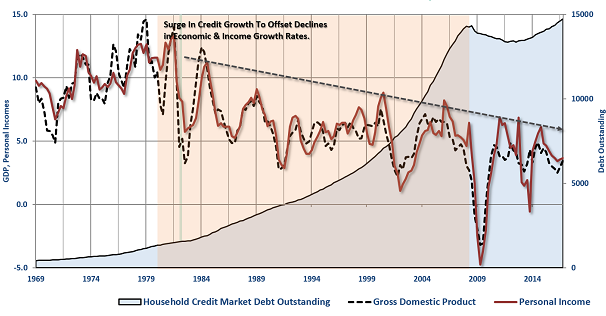
The unsustainable path for households and for government do not seem to matter to the bulk of economists, politicians or monetary policy authorities at the Federal Reserve. Apparently, ever-declining borrowing costs are a panacea.

Keep in mind, though, the Fed has been hiking the overnight lending rate. Hiking the overnight lending rate may or may not lead to a higher cost of capital in the belly of the borrowing beast (e.g., 5 years, 7 years, 10 years). That said, banks are already decreasing their willingness to lend to consumers. Meanwhile, commercial and industrial loans have been dropping precipitously.
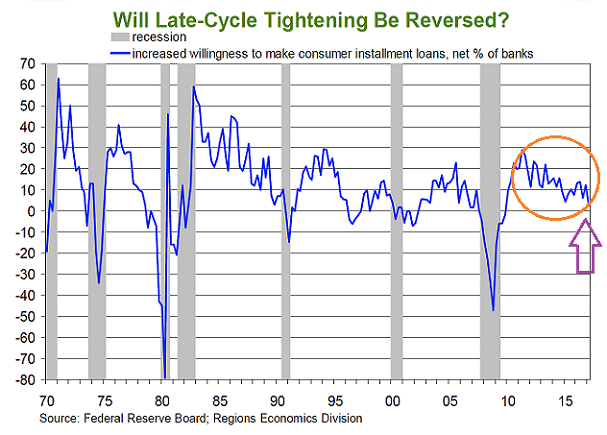
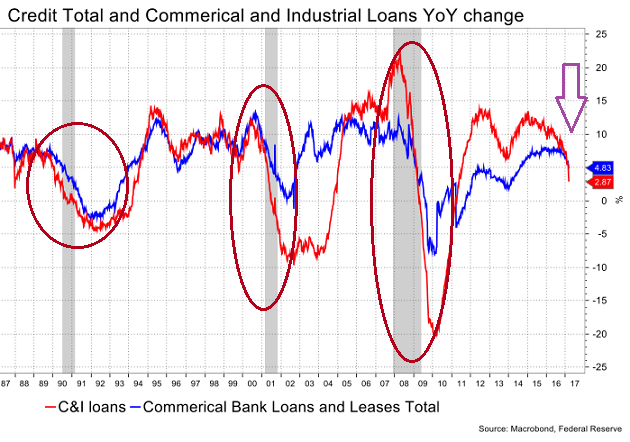
Credit constriction and excessive debt levels hinder an economy that depends so heavily on borrowing. Granted, tax cuts and regulatory overhaul may offer hope to reduce the dependence on leverage. Still, genuine economic acceleration requires more than hope. It’s one thing to to talk about consumer confidence reaching heights not seen since the year 2000. It’s another thing for millions more working-aged individuals to leave the labor force than join it since the year 2000.
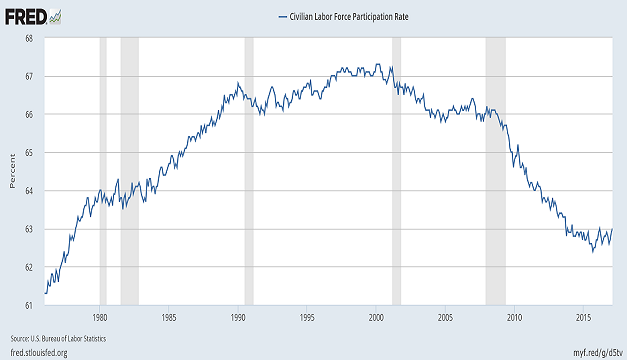
Has the exodus from the workforce abated? Indeed, over the last three years, we have stabilized in and around a 63% labor force participation rate. Yet the difference between a 66% pre-Great Recession rate and the 63% we have here in March of 2017 amounts to 10 million or more non-employed working-aged citizens. Those 10-million plus who no longer work and who no longer produce effectively take from those who do.
Perhaps I would have far more faith in the efficacy of tax cuts and regulatory rollbacks on stock price gains if valuations themselves had not gone parabolic. Unfortunately, valuation extremes are very real. Highest median price-to-sales (P/S) ratio ever for the S&P 500. 2nd highest price-to-earnings (P/E, CAPE) ratios ever. And a market cap-to-GDP ratio with only the tech bubble as a rival.
We should give particular credence to the total value of the stock market (market cap) as it relates to the economy (GDP). Why? It has a rather impressive resume in forecasting 10-year forward returns. At the present moment, market-cap to GDP suggests we’re looking at annualizing at -2.5% over the next decade.
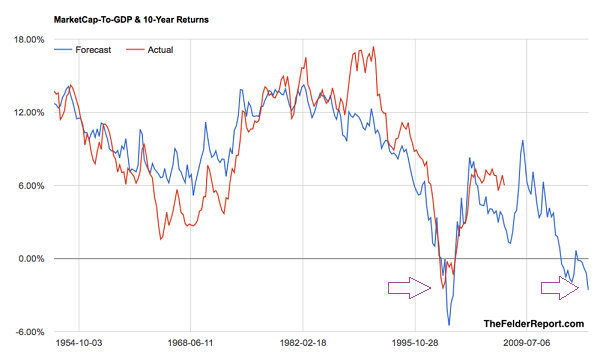
It may be true that Warren Buffett is less enthusiastic about the importance of market-cap-to-GDP as a valuation tool. He may wish that it did not come to be known as the the “Buffett Indicator.” Nevertheless, even Jack Bogle, Warren Buffett’s hero, projects little more than 4% annual over the next decade.
In essence, acquiring stock shares at elevated levels today is unlikely to deliver long-term historical stock returns of 9.5%-10%. Acquiring them when the P/E and P/S for the S&P 500 are bargains – acquiring shares when market cap is closer to 60% of GDP rather than 120% of GDP – improves one’s long-term prospective returns immensely.
If an investor is in his/her 20s or 30s or even early 40s, perhaps he she might not need to concern himself with the price paid for ownership. Just buy the darn house (or stock shares) and everything will work out over the next 45-50 years.
If you are in your mid-40s or a near-retiree in your 50s or retiree in your 60s, however, you ought to be mindful of the time it can take to recover principal (not to mention inflation-adjusted purchasing power). The dollars cannot necessarily be replaced from any other source of income.
If you have a means for accumulating an impressive cash position (25%) without selling core holdings, feel free to do so. If you do not have the means – if you must accumulate cash by selling some assets – you might consider this path. Regardless, cash is necessary for a future opportunity to buy stocks when valuations revert to a historical mean.
The overwhelming majority of near-retirees and retirees do not have an endless stash of cash to purchase in corrective periods or bear markets. They need to sell some assets higher when others are greedy. In that manner, a cash position will allow them to buy stocks lower in corrective periods… when others are fearful.
Buying lower when others are fearful and selling higher when others are greedy is part of a successful long-term investing approach. Sadly, there are those who will still deride you as a evil “market timer.” Let them. It is better to raise some cash to reduce the possibility of severe financial loss than to win media approval for holding-n-hoping.
